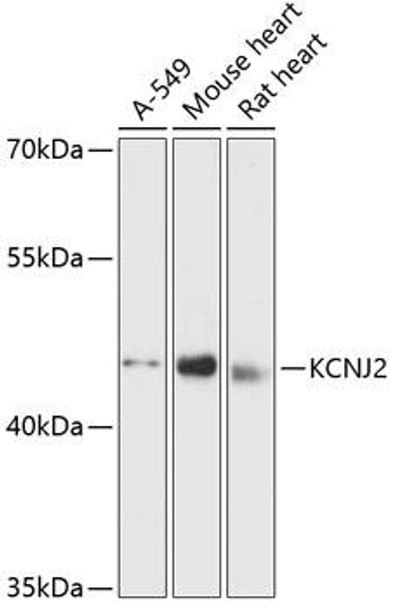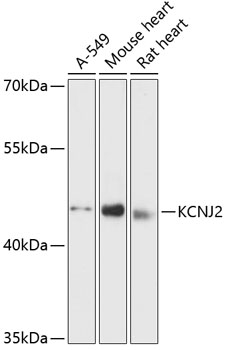Anti-KCNJ2 Antibody (CAB12949)
- SKU:
- CAB12949
- Product type:
- Antibody
- Reactivity:
- Human
- Reactivity:
- Mouse
- Reactivity:
- Rat
- Host Species:
- Rabbit
- Isotype:
- IgG
- Antibody Type:
- Polyclonal Antibody
- Research Area:
- Signal Transduction
Description
| 抗体名: | Anti-KCNJ2 Antibody |
| 抗体コード: | CAB12949 |
| 抗体サイズ: | 20uL, 50uL, 100uL |
| 申し込み: | WB IHC |
| 反応性: | Human, Mouse, Rat |
| 宿主種: | Rabbit |
| 免疫原: | Recombinant fusion protein containing a sequence corresponding to amino acids 318-427 of human KCNJ2 (NP_000882.1). |
| 申し込み: | WB IHC |
| 推奨希釈: | WB 1:500 - 1:2000 IHC 1:50 - 1:200 |
| 反応性: | Human, Mouse, Rat |
| ポジティブサンプル: | A-549, Mouse heart, Rat heart |
| 免疫原: | Recombinant fusion protein containing a sequence corresponding to amino acids 318-427 of human KCNJ2 (NP_000882.1). |
| 精製方法: | Affinity purification |
| ストレージバッファ: | Store at -20'C. Avoid freeze / thaw cycles. Buffer: PBS with 0.02% sodium azide, 50% glycerol, pH7.3. |
| アイソタイプ: | IgG |
| 順序: | NEIL WGHR YEPV LFEE KHYY KVDY SRFH KTYE VPNT PLCS ARDL AEKK YILS NANS FCYE NEVA LTSK EEDD SENG VPES TSTD TPPD IDLH NQAS VPLE PRPL RRES EI |
| 遺伝子ID: | 3759 |
| Uniprot: | P63252 |
| セルラーロケーション: | Lipid-anchor, Membrane, Multi-pass membrane protein |
| 計算された分子量: | 48kDa |
| 観察された分子量: | 48kDa |
| 同義語: | KCNJ2, ATFB9, HHBIRK1, HHIRK1, IRK1, KIR2.1, LQT7, SQT3 |
| バックグラウンド: | Potassium channels are present in most mammalian cells, where they participate in a wide range of physiologic responses. The protein encoded by this gene is an integral membrane protein and inward-rectifier type potassium channel. The encoded protein, which has a greater tendency to allow potassium to flow into a cell rather than out of a cell, probably participates in establishing action potential waveform and excitability of neuronal and muscle tissues. Mutations in this gene have been associated with Andersen syndrome, which is characterized by periodic paralysis, cardiac arrhythmias, and dysmorphic features. |
| UniProt Protein Function: | KCNJ2: Probably participates in establishing action potential waveform and excitability of neuronal and muscle tissues. Inward rectifier potassium channels are characterized by a greater tendency to allow potassium to flow into the cell rather than out of it. Their voltage dependence is regulated by the concentration of extracellular potassium; as external potassium is raised, the voltage range of the channel opening shifts to more positive voltages. The inward rectification is mainly due to the blockage of outward current by internal magnesium. Can be blocked by extracellular barium or cesium. Defects in KCNJ2 are the cause of long QT syndrome type 7 (LQT7); also called Andersen syndrome or Andersen cardiodysrhythmic periodic paralysis. Long QT syndromes are heart disorders characterized by a prolonged QT interval on the ECG and polymorphic ventricular arrhythmias. They cause syncope and sudden death in response to excercise or emotional stress. LQT7 manifests itself as a clinical triad consisting of potassium-sensitive periodic paralysis, ventricular ectopy and dysmorphic features. Defects in KCNJ2 are the cause of short QT syndrome type 3 (SQT3). Short QT syndromes are heart disorders characterized by idiopathic persistently and uniformly short QT interval on ECG in the absence of structural heart disease in affected individuals. They cause syncope and sudden death. SQT3 has a unique ECG phenotype characterized by asymmetrical T waves. Defects in KCNJ2 are the cause of familial atrial fibrillation type 9 (ATFB9). ATFB9 is a familial form of atrial fibrillation, a common sustained cardiac rhythm disturbance. Atrial fibrillation is characterized by disorganized atrial electrical activity and ineffective atrial contraction promoting blood stasis in the atria and reduces ventricular filling. It can result in palpitations, syncope, thromboembolic stroke, and congestive heart failure. Belongs to the inward rectifier-type potassium channel (TC 1.A.2.1) family. KCNJ2 subfamily. |
| UniProt Protein Details: | Protein type:Channel, potassium; Membrane protein, integral; Membrane protein, multi-pass Chromosomal Location of Human Ortholog: 17q24.3 Cellular Component: integral to plasma membrane; intrinsic to membrane; plasma membrane; voltage-gated potassium channel complex Molecular Function:G-protein activated inward rectifier potassium channel activity; inward rectifier potassium channel activity; phosphatidylinositol-4,5-bisphosphate binding Biological Process: cellular potassium ion homeostasis; potassium ion import; potassium ion transport; protein homotetramerization; regulation of resting membrane potential; regulation of skeletal muscle contraction via membrane action potential Disease: Andersen Cardiodysrhythmic Periodic Paralysis; Atrial Fibrillation, Familial, 9; Short Qt Syndrome 3 |
| NCBI Summary: | Potassium channels are present in most mammalian cells, where they participate in a wide range of physiologic responses. The protein encoded by this gene is an integral membrane protein and inward-rectifier type potassium channel. The encoded protein, which has a greater tendency to allow potassium to flow into a cell rather than out of a cell, probably participates in establishing action potential waveform and excitability of neuronal and muscle tissues. Mutations in this gene have been associated with Andersen syndrome, which is characterized by periodic paralysis, cardiac arrhythmias, and dysmorphic features. [provided by RefSeq, Jul 2008] |
| UniProt Code: | P63252 |
| NCBI GenInfo Identifier: | 54037433 |
| NCBI Gene ID: | 3759 |
| NCBI Accession: | P63252.1 |
| UniProt Secondary Accession: | P63252,O15110, P48049, |
| UniProt Related Accession: | P63252 |
| Molecular Weight: | 48kDa |
| NCBI Full Name: | Inward rectifier potassium channel 2 |
| NCBI Synonym Full Names: | potassium voltage-gated channel subfamily J member 2 |
| NCBI Official Symbol: | KCNJ2 |
| NCBI Official Synonym Symbols: | IRK1; LQT7; SQT3; ATFB9; HHIRK1; KIR2.1; HHBIRK1 |
| NCBI Protein Information: | inward rectifier potassium channel 2 |
| UniProt Protein Name: | Inward rectifier potassium channel 2 |
| UniProt Synonym Protein Names: | Cardiac inward rectifier potassium channel; Inward rectifier K(+) channel Kir2.1; IRK-1; hIRK1; Potassium channel, inwardly rectifying subfamily J member 2 |
| Protein Family: | Inward rectifier potassium channel |
| UniProt Gene Name: | KCNJ2 |


